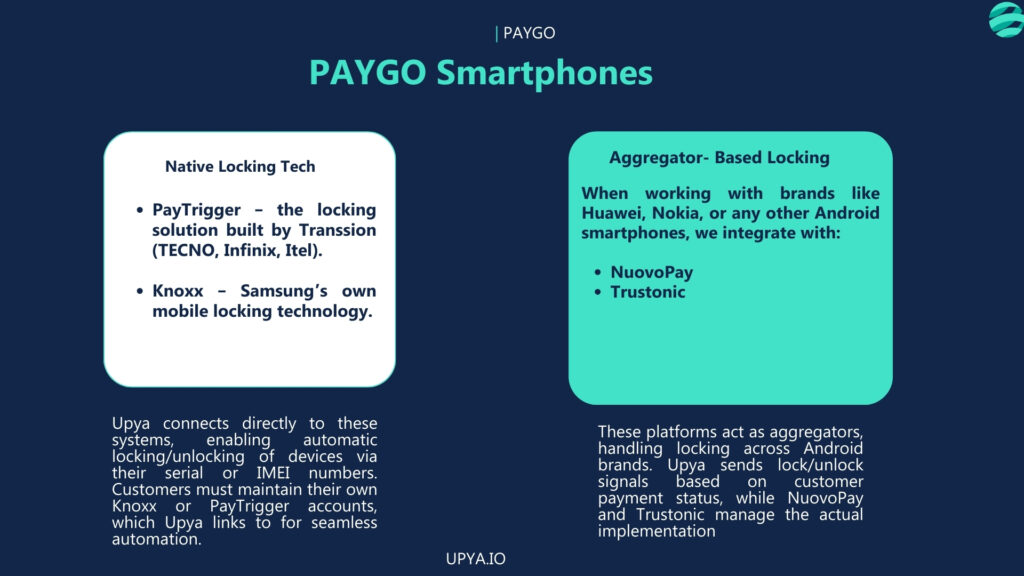At Upya, we partner with manufacturers across sectors to offer a powerful ERP/CRM/LMS solution that “speaks” directly to devices being sold and managed — such as solar water pumps, electric meters, and smartphones.
Our technology enables remote control of these devices, especially in Buy Now Pay Later (BNPL), PAYGO (Pay-As-You-Go), and Lipa Pole Pole (deposit + 12-month installment) schemes. When a customer makes a payment, our system sends an unlock signal for a specific time period (days, weeks, months). If payments are missed, a lock signal is triggered until payment resumes.
Here’s a quick breakdown of how Upya works with different manufacturers to lock or unlock their products.
Table of Contents
Overview of Locking Mechanisms
Cloud-Based Locking
Upya can send lock/unlock messages to a manufacturer’s cloud platform — either automatically or manually — to manage a device.
We do not communicate directly with the device, but with the manufacturer’s cloud system, which in turn controls the IoT functions of the device.
🔸 Example:
We are integrated with SparkMeter and their Koios cloud platform. When a payment is made, Upya triggers a request to top-up a meter’s balance. When the balance runs low, SparkMeter notifies us, and we send an SMS to the customer prompting another payment.
SIM Card-Based Locking
This method is common in products like solar pumps with embedded SIM cards. Upya sends SMS commands directly to the device’s SIM card (e.g., “Sn0000comfnnnxxxx”). The manufacturer programs the device to respond to these messages, unlocking or locking the device for a defined time.
Why use SIM-based locking?
It doesn’t require internet — just GSM coverage.
It’s ideal for rural or remote regions.
Using multi-network M2M SIM cards, devices can also push usage data to the manufacturer’s system.
Token-Based Locking (Offline Activation Codes)
Widely used in the PAYGO solar home systems (SHS) and Productive Use Equipment (PUE) sectors, this method leverages cryptographic tokens to lock or unlock a device.
Each token contains:
The device serial number and manufacturer,
Whether it’s a lock or unlock command,
The activation period (e.g., 5 days).
The end-user enters the code manually using a keypad or display. The device validates the code and activates for the specified period — fully offline.
🔹 Advantages:
No internet or GSM needed.
Works in extremely remote locations.
Some partners we work with: Biolite, SunCulture, and Koolboks.
As soon as a payment is made, Upya automatically retrieves and sends the activation code to the customer via Bulk SMS.
➡️ Are you a manufacturer looking to implement token-based locking? Learn more via OpenPAYGO Token.
PAYGO Smartphones: Our Work in Mobile Financing
Upya also supports smartphone financing under PAYGO or BNPL models across Sub-Saharan Africa and Latin America. We have direct integrations with systems that can lock/unlock over 150 smartphone brands.

Conclusion
Upya’s flexibility and strong API integrations allow us to adapt to any locking mechanism — from online cloud commands to offline activation tokens. Our goal is simple: give our B2B customers all the tools they need to digitize field operations, manage customer payments, and ensure control of distributed devices.
Whether you’re selling smart meters, SHS kits, solar fridges, or smartphones, Upya helps you stay connected and in control.
Explore more about our ERP/CRM/LMS system here:
